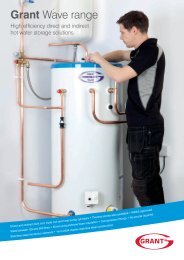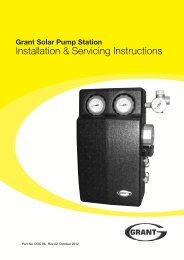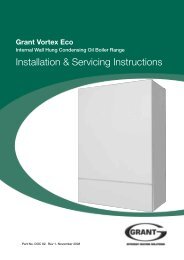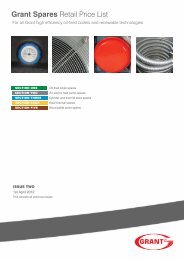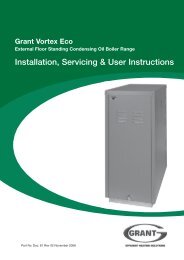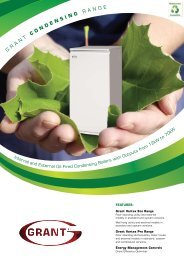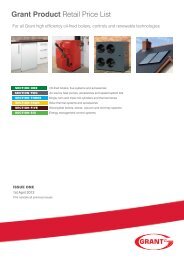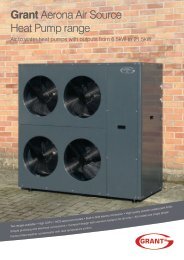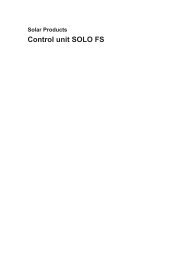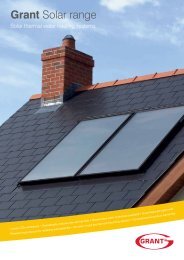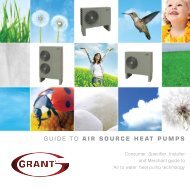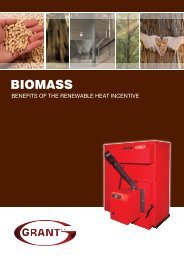Installation & Servicing Instructions - Grant UK
Installation & Servicing Instructions - Grant UK
Installation & Servicing Instructions - Grant UK
You also want an ePaper? Increase the reach of your titles
YUMPU automatically turns print PDFs into web optimized ePapers that Google loves.
6 Condensate Disposal<br />
6.1 General Requirements<br />
When in condensing mode the <strong>Grant</strong><br />
VORTEX Pro boilers produce condensate<br />
from the water vapour in the flue gases.<br />
This condensate is slightly acidic with a<br />
ph value of around 3 (similar to vinegar).<br />
Provision must be made for the safe and<br />
effective disposal of this condensate.<br />
Condensate can be disposed of using one<br />
of the following methods of connection:<br />
Internal connection (preferred option):<br />
• into an internal domestic waste<br />
system (from kitchen sink, washing<br />
machine, etc.)<br />
• directly into the soil stack<br />
External connection:<br />
• into an external soil stack<br />
• into an external drain or gulley<br />
• into a rainwater hopper (that is part<br />
of a combined system where sewer<br />
carries both rainwater and foul water)<br />
• purpose made soakaway<br />
All condensate disposal pipes must<br />
be fitted with a trap - whether they are<br />
connected internally or externally to a<br />
domestic waste system/soil stack or run<br />
externally to a gully, hopper or soakaway.<br />
6.2 Connections<br />
Connections into a rainwater hopper, external<br />
drain or gulley should be terminated inside the<br />
hopper/drain/gulley below the grid level but<br />
above the water level.<br />
Condensate disposal pipes should not<br />
be connected directly into rainwater<br />
downpipes or to waste/soil systems<br />
connected to septic tanks.<br />
Condensate should not be discharged<br />
into 'grey water' systems that re-use<br />
water used in the home (not including<br />
water from toilets).<br />
It should be noted that connection of a<br />
condensate pipe to the drain may be subject<br />
to local Building Control requirements.<br />
6.3 Pipework<br />
Condensate disposal pipework must be<br />
plastic (plastic waste or overflow pipe is<br />
suitable).<br />
!<br />
NOTE<br />
IMPORTANT: Copper or steel pipe is<br />
NOT suitable and MUST NOT be used.<br />
Condensate disposal pipes should<br />
have a minimum 'nominal' diameter<br />
of 22 mm (¾") - e.g. use 21.5 mm OD<br />
polypropylene overflow pipe.<br />
Condensate disposal pipes must be<br />
fitted with a fall (away from the boiler) of<br />
at least 2.5° (~45 mm fall per metre run).<br />
!<br />
NOTE<br />
Where it is not possible for the pipe to<br />
fall towards the point of discharge -<br />
either internally into a waste system or<br />
externally to a gulley (e.g. for boilers<br />
installed in a basement), it will be<br />
necessary to use a condensate pump.<br />
Condensate disposal pipes should<br />
be kept as short as possible and the<br />
number of bends kept to a minimum.<br />
Pipes should be adequately fixed to<br />
prevent sagging, i.e. at no more than 0.5<br />
metre intervals.<br />
6.4 External Pipework<br />
Ideally, external pipework, or pipework<br />
in unheated areas, should be avoided. If<br />
unavoidable, external pipework should<br />
be kept as short as possible (less than 3<br />
metres) and 32 mm waste pipe used to<br />
minimise the risk of ice blocking the pipe<br />
in freezing conditions.<br />
The number of bends, fittings and joints<br />
on external pipes should be kept to a<br />
minimum to reduce the risk of trapping<br />
condensate.<br />
Figure 6-1: Purpose made condensate soakaway<br />
!<br />
NOTE<br />
For boiler installed in an unheated<br />
area such as an outhouse or garage,<br />
all condensate pipework should be<br />
considered as an ‘external’.<br />
6.5 Condensate Soakaway<br />
To keep external pipework to a<br />
minimum, locate the soakaway as close<br />
as possible to the boiler but ensure<br />
it is at least 500 mm from building<br />
foundations and away from other<br />
services, e.g. gas, electricity, etc.<br />
The condensate pipe may be run above<br />
or below ground level and can enter<br />
either the top or side of the soakaway<br />
tube. Refer to Figure 6-1.<br />
Ensure that the drainage holes in the<br />
soakaway tube face away from the building.<br />
Backfill both the soakaway tube, and the<br />
hole around it, with 10 mm limestone<br />
chippings.<br />
Only use a soakaway where the soil is<br />
porous and drains easily. Do not use in clay<br />
soils or where the soil is poorly drained.<br />
!<br />
CAUTION<br />
Any damage due to condensate backing<br />
up into the boiler due to a high water<br />
table, in the case of a soakaway, or<br />
flooded drains when the condensate<br />
disposal is via a gulley or soil stack, is not<br />
covered by the <strong>Grant</strong> product warranty.<br />
32 mm waste pipe external to the building<br />
Cement seal<br />
100 mm plastic tube Sealed end Backfill with 10 mm<br />
limestone chippings<br />
O<br />
Minimum 2.5 fall<br />
Ground level<br />
25 mm<br />
300 mm<br />
400 mm<br />
min.<br />
Two rows of 3 x 12 mm<br />
holes at 25 mm centres<br />
and 50 mm from the bottom<br />
of the tube. Holes facing<br />
away from the property.<br />
Condensate<br />
Disposal<br />
17



